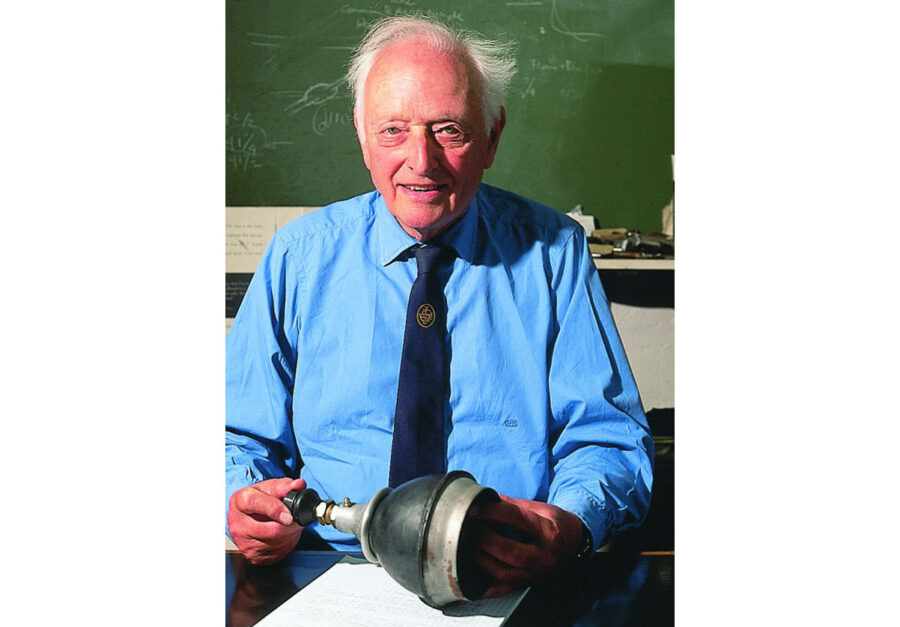Died 9th December 2012, Bath, UK
Buried Christ Church, Bradford-upon-Avon, UK
Era Modern
In the 1950s, Moulton developed the cone suspension unit that was used in Minis from 1959 until 2000 — a truncated cone (frusto-conical) rubber spring and shock absorber, consisting of a cup-shaped body of rubber bonded between steel plates and attached to a metal arm ending in a ball joint. The ball joint slots into a socket on the wheel strut and, as he noted, "resembles the typical anatomy of a muscle-actuated limb".

Alex Moulton was granted more than 250 patents in his lifetime, 90 percent of them as sole author and 58 percent of them in Britain. His most prolific decades were the 1950s and 60s, covering at least 148 patents. He always devised names for his inventions as he thought that a distinctive word describing their purpose would be memorable.

| 1920 | Born 9th April in Stratford-upon-Avon at his maternal grandmother's house, third child of Major John Coney Moulton OBE (1886-1926, army officer and naturalist/zoologist, curator of Sarawak Museum c1905-15) and Beryl Latimer Greene (1886-1972) with siblings — John G. (b.1916) and Elizabeth Dione (1918-2003) |
| 1928 on | Raised by mother and grandmother (father died 1926) at The Hall, Bradford-on-Avon (in Moulton family since 1848), first bike: a Hercules |
| c.1929-33 | Attends Arden House prep school, Henley-in-Arden |
| 1933-38 | Boards at Marlborough College, builds a steam car (GN chassis and chain drive, powered by a two cylinder Locomobile engine, boiler heated by a Calor-gas Simpson burner) using own lathe, and is pupil apprentice at Sentinel Waggon Works, Shrewsbury (under Abner Doble [1890-1961]) |
| 1938 | Reads mechanical engineering at King's College in Cambridge, studies interrupted by World War II, volunteers for service |
| 1939-45 | Working (from September) in engine research department at Bristol Aeroplane Company (Filton), initially testing superchargers and carburettors |
| 1940 | Promoted (September) to personal assistant to chief engineer Sir Roy Fedden (1885-1973), working in reserved occupation on RAF engines including the 18 cylinder Centaurus |
| 1945 | Joins George Spencer Moulton & Co (Moultons owned the factory), assists works manager James 'Jimmy' Chrystal and rubber chemist Dr Samuel Shrowder Pickles (1878-1962) |
| 1946-7 | Sets up research department studying rubber technology and rubber-to-metal bonding |
| 1947 | Resumes studies at King's College, graduates after four terms |
| 1947 | Returns to Spencer Moulton, continues investigating rubber-to-metal bonding, pioneers rubber suspension ideas |
| 1948 | Invents Flexitor suspension spring (sleeve of rubber twisted in torsion) for caravan and boat trailers and the Austin Gipsy, installs rubber suspension on aeronautical engineer Ian Duncan's Dragonfly car, British Motor Corporation (BMC) shows interest in Flexitor |
| 1949 | Meets Alexander Arnold 'Alec' Issigonis (1906-88, knighted 1969) who is unconvinced about rubber suspension for vehicles ("Rubber is not an engineering material") |
| c.1949-50 | Recruits Philip Wilson Turner (1921-2001, physicist) from University of Cambridge to work on fatigue and creep tests, sets up subsidiary Spencer Moulton Flexitor Ltd, fits rubber rear suspension to motorbikes (Vincent HRD Comet, and Enfield) |
| 1950-51 | Two papers with Turner — Influence of Design on Rubber Springs (1950), Development and Testing of a Series of Rubber Suspension Units (1951) |
| 1950s | Experiments (early 1950s) with fitting Flexitor to a Leyland Olympic Bus, converts a Thorneycroft craft lorry to use Flexitor |
| 1952 | Working with Issigonis on TA350 car suspension at Alvis in Coventry, devising independent suspension with fluid interconnection |
| 1953 | Working with William John 'Jack' Daniels (1912-2004) in research department of BMC at Cowley, fits a Morris Minor with rubber suspension (front: Flexitor, rear: Rotashear) and removes the torsion bars, tests car on cobblestone track at Motor Industries Research Association in Nuneaton for 1,600km without failure (compare coil spring suspension: ave 800km) |
| 1955-59 | Issigonis returns to BMC as chief engineer and explores using Moulton's rubber suspension on Austin/Morris cars including the Mini (1959) |
| 1956 | Spencer Moulton in financial difficulty and sold (1st January) to Avon India Rubber Co Ltd for 6s 6d (32.5p) per share, Moulton appointed technical consultant to Avon |
| 1956 | Founds Moulton Developments Ltd |
| 1957-59 | Working on the analysis and redesign of bicycles, leading to the creation of the Moulton Bicycle |
| 1959 | Launch of the Mini (October) at British International Motor Show in London, featuring Moulton rubber cone spring suspension |
| 1959 | First bicycle patent (applied 16th November 1959, granted 27th October 1960) |
| 1960 | Licensing agreement (October) with Raleigh but project abandoned (January 1962) |
| 1962 | Sets up Moulton Bicycles Limited (April), builds bicycle factory on The Hall estate, commences manufacture in conjunction with BMC (Kirkby, Liverpool) |
| 1962 | Perfects the design of Hydrolastic suspension (August) |
| 1962 | Moulton Bicycle unveiled (November) at Cycle & Motor Cycle Show in London to great acclaim |
| 1964 | Diploma di Medaglia d'Oro (gold medal diploma) in Milan, some Minis fitted with Hydrolastic suspension (and Austin 1800, Maxi and Allegro) |
| 1967 | Awarded honorary doctorate by Royal College of Art, and a Queen's Award for Technical Innovation |
| 1967 | "Distress sale" (29th July) of Moulton Bicycles Limited to Raleigh, retained as a Raleigh consultant, some bikes produced by Raliegh without front suspension: the frames crack |
| 1967-69 | Anthony 'Tony' Best joins Moulton Developments (1967) as chief engineer working on vehicle suspension and leads evolution from Hydrolastic to Hydragas, company moves from iterative testing to computer modelling |
| 1968 | Elected to the Faculty of Royal Designers for Industry for his engineering products |
| c.1970 | Designs and builds a lorry with Hydrolastic suspension, and a prototype (not produced) long-distance bus with Hydragas suspension — body by Moulton Developments, chassis of British Leyland truck parts, eight wheels, twin front steering axles, Perkins engine, smooth ride and safe handling |
| 1971 | Awarded honorary doctorate by University of Bath |
| 1973 | Leads Royal Institution Discourse on results of fundamental research into power required to drive a bicycle, Austin Allegro fitted with Hydragas suspension |
| 1974-75 | Raleigh ceases (1974) Moulton Bicycle manufacture and terminates (31st January 1975) consultancy agreement |
| 1975 | Incorporates Moulton Developments Limited (18th March), begins designing a tubular space frame bicycle, Moulton Bicycle Club founded, Austin Princess fitted with Hydragas suspension. |
| 1976 | Awarded CBE for services to industry |
| 1977 | Registers (25th March) The Alex Moulton Charitable Trust |
| 1979 | Rides (11th November) the first prototype of the space frame bike in the Peak District, testing continues in secret |
| 1980 | Made Fellow of Royal Academy of Engineering |
| 1980 | Austin Mini Metro fitted with Hydragas, though the suspension units not connected front-to-rear as intended |
| 1981-3 | Master of Faculty of Royal Designers for Industry |
| 1982 | Closes Moulton Developments, Austin Ambassador produced until 1984 with Hydragas suspension |
| 1983 | Buys back own designs and patents from Raleigh, forms new company Alex Moulton Bicycles in Bradford-on-Avon, launches (19th May) two space frame models (bicycles "for doctors, engineers and perfectionists") |
| 1985-8 | Vice President, Royal Academy of Engineering |
| 1987 | (silver) Jubilee model space frame produced to mark the 25th anniversary of Moulton bicycles |
| 1988 | Offers space frame bike to Raleigh for manufacture (declined), produces first full suspension mountain bike (AM-ATB) |
| 1990 | Rover Metro/Rover 100 fitted with interconnected Hydragas suspension |
| 1992 | Licences Pashley of Stratford-upon-Avon to make the more affordable space frame all purpose bicycle (APB) in high tensile steel tubing, design derived from the ATB |
| 1994 | Awarded honorary doctorate, Cranfield University |
| 1995 | MGF roadster launched with Hydragas suspension |
| 1997 | Awarded Sir Misha Black Medal for distinguished services in design education (Design & Industries Association, Faculty of Royal Designers for Industry and Royal Academy of Engineering), made Fellow of the Institution of Mechanical Engineers |
| 2000 | Licenses Bridgestone in Japan to make an aluminium Moulton bicycle based on the original F-Frame |
| 2002 | 12 millionth and last new car (an MGF) to be fitted with Hydragas suspension |
| 2005 | Institution of Engineering Designers Gerald Frewer Memorial Trophy for contributions to bicycle and vehicle design, highly commended in Prince Philip Design Awards, Moulton bicycle wins New Designers competition for iconic example of British ingenuity |
| 2008 | Re-organisation of Alex Moulton Limited |
| 2009 | Inaugurates Institution of Engineering Designers Alex Moulton Award for innovative and inspiring designers |
| 2010 | Launches (9th April) a "radical redesign" of the Moulton bicycle on his 90th birthday — Prototype MDev 90, a slimline space frame stiffened with carbon fibre, designed for rapid assembly |
| 2012 | Hosts a celebration (November) of 50 years of the Moulton Bicycle |
| 2012 | Dies (9th December) from a respiratory tract infection |
| 2012 | Funeral (19th December) at Bradford-on-Avon, Holy Trinity Church, cortege greeted by a bicycle guard of honour staged by Moulton Bicycle Club members, buried in family grave, most of his £4.2m estate passes to the charitable trust |
| 2015 | Moulton Developments Limited dissolved (27th October) |
Hydrolastic Suspension System, Bradford-on-Avon, Wiltshire, UK .... 1955-62
Suspension system for the Mini, Bradford-on-Avon, Wiltshire, UK .... 1957-59
Moulton F-Frame Bicycle, Bradford-on-Avon, Wiltshire, UK .... 1957-62
Hydragas Suspension System, Bradford-on-Avon, Wiltshire, UK .... 1967-73
Moulton Space Frame Bicycle, Bradford-on-Avon, Wiltshire, UK .... 1975-83
Moulton New Series Bicycle, Bradford-on-Avon, Wiltshire, UK .... 1998
MDev 90 prototype bicycle, Bradford-on-Avon, Wiltshire, UK .... 2010






